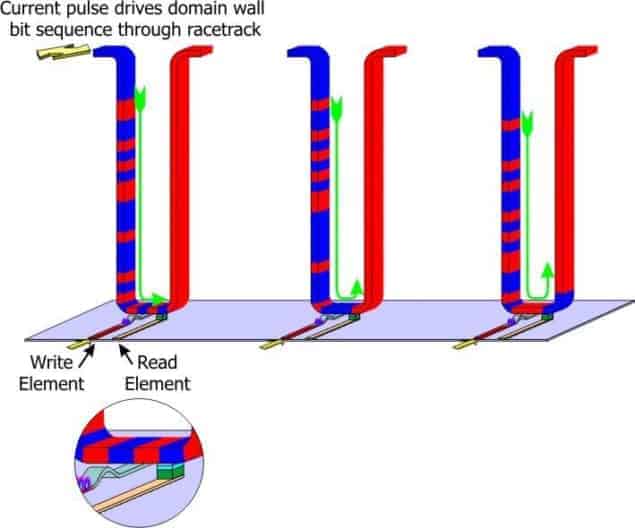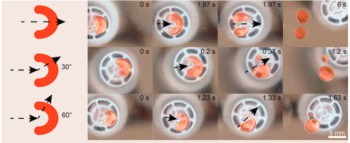
IBM researchers have moved another step closer to commercializing “racetrack memory” – a new technology that uses magnetic nanowires as high-density data storage devices. Racetrack involves moving magnetic domain walls – the boundaries between regions of opposite magnetization – along a nanowire using small spin-polarized current pulses. It could make for a new type of magnetic memory that can store up to 100 times more data than existing random-access memories (RAMs).
A conventional computer hard drive uses a motor to rotate glass discs on which magnetic bits are stored in a thin film. Racetrack memory is radically different because it uses electric currents to move magnetic domain walls up and down a nanowire without displacing any atoms at all. Magnetic domain walls are narrow boundaries between regions in a material where the magnetic moments point “up” on one side of the wall and “down” on the other. Walls can be moved inside a material by applying an external magnetic field or by injecting a spin-polarized current pulse (a current of spin-polarized electrons that carries spin angular momentum).
In a racetrack memory, data are stored as a sequence of magnetic domains – separated by domain walls – along a nanowire and individual bits are stored and retrieved by moving the sequence along the nanowire and across magnetic read and write devices. A typical racetrack chip would contain arrays of nanowires a few microns long and about 30 nm wide and could store hundreds of gigabytes of data.
Do walls move instantly?
Stuart Parkin’s team at IBM Almaden Research Center in San Jose, California, has been working on the technology since 2004 and has already developed some basic racetrack prototypes that can read and write simple data sets. However, until now, the researchers did not know how magnetic domain walls move in a nanowire. Do the walls move instantly as soon as the current is applied and come to a stop straight away when the current is switched off, or do they take time to reach their peak velocity and come to a slow stop when there is no current?
Parkin and colleagues say that the second scenario holds true. The researchers came to their conclusion by measuring the time it takes for a domain wall to accelerate to its peak velocity and the distance travelled by the domain wall when it is excited by a current pulse. They did this by using an exciting current pulse and a second probe current pulse while also measuring the time it takes for the domain wall to decelerate from this peak velocity to zero when the current is switched off.
‘Surprisingly long’ time and distance
“We found that the time required for acceleration/deceleration is surprisingly long at around 10 ns and the distance travelled is long too at around 1 µm,” Parkin told physicsworld.com. “However, the distance lagged during acceleration is the same as the distance moved by the domain under its own inertia (or mass) when the current is switched off.” This latter finding is very important because it means that, although the domain wall has inertia, it still moves a distance that corresponds to the length of the applied current pulse. Knowing this, the researchers will thus now be able to precisely control the position of the domain wall along the racetrack by using carefully tailored current pulses or sequences of pulses and so accurately move and retrieve data on it.
“This is clearly an important breakthrough in our understanding of current-driven domain wall dynamics relevant to building racetrack memories,” stated Parkin.
The IBM team followed domain wall motion by measuring the resistance of racetracks made of permalloy – a soft magnetic alloy made of nickel and iron. The presence of a domain wall slightly lowers the resistance of the nanowire.
‘Ingenious technique’
“We use the resistance of the nanowire to determine not only whether a domain wall is present, but also the number of domain walls and even the detailed internal magnetic structure of the domain wall,” explained Parkin. “We used a rather ingenious technique that involves combining two current pulses – one to excite the domain wall and the second to probe the domain wall’s motion – somewhat akin to pump-probe techniques using photon pulses.”
The researchers now plan to build an integrated prototype of a racetrack memory with reading, writing and shifting elements built into the track itself.
The work is reported in Science 330 1810.



